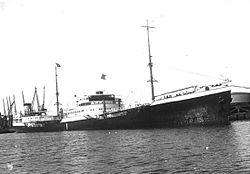Stedingen (ship)
|
The sister ship Diala
|
||||||||||||||||||||||
|
||||||||||||||||||||||
|
||||||||||||||||||||||
|
||||||||||||||||||||||
|
||||||||||||||||||||||
The tanker Stedingen was ordered in 1937 by the British Anglo-Saxon Petroleum Co. as a Discina from Bremer Vulkan . The motorboat was transferred Northwest German tanker shipping company in Hamburg after the war broke the German subsidiary. When it was launched on October 10, 1939, it was named Posidonia .
In 1940 the ship was used as part of the “Weser Exercise” company as part of the so-called “tanker squadron” and was supposed to go to Stavanger . On April 8, 1940, the tanker was ordered to stop in the Skagerrak by the British submarine HMS Trident that appeared . The ship tried to escape into Norwegian territorial waters. When the submarine opened fire, the Stedingen was sunk by its crew.
history
The Stedingen was created as part of a major order from the British tanker shipping company Anglo-Saxon Petroleum Co. from German shipyards. It was ordered as a Discina from Bremer Vulkan. The shipyard had built tankers for the British company as early as 1931. In 1935, the first single-engine 12,000 t motor tanker Alexia was built at the Bremen shipyard , followed by the Tornus and Diala before the war . Other ships of this type were built in Hamburg, but also in Great Britain and Italy.
When the new building 773 was launched on October 10, 1939, it was named Posidonia . On the 18th, the completed Posidonia was delivered to Nordwestdeutsche Tankschiff Reederei GmbH in Hamburg, a German subsidiary of Anglo-Saxon. The Dutch-British Shell group was still active in Germany at the time. However, the Navy took over the new ship in January 1940 as a base tanker in Wilhelmshaven and renamed it Stedingen .
War effort
In 1940 the new Stedingen was used as part of the “Weserübungen” company as part of the so-called “tanker squadron”, which consisted of four large and five small tankers. Of the large tankers, the Kattegat was the first to leave Wilhelmshaven on April 3 with the destination Narvik , mainly with heating oil for the large units of the Kriegsmarine. Its sister ship the Skagerrak , also with heating oil and similar tasks for the ships and boats of the Navy, followed on the 4th to Trondheim . On April 6th the whaling mother ship Jan Wellem with 5125 tons. Heating oil, 5120 to. Gas oil, 700 to. Water, 170 m³ lubricating oil and 500 to. Provisions left Teriberka Bay near Murmansk (so-called Base North ) for Narvik, which it reached as planned on April 8 before the attacking ten German destroyers who were supposed to supply it.
The Stedingen was the last of the large tanker until April 7 to Stavanger on the march. Unlike the other large tankers that were supposed to supply the units of the Kriegsmarine, it had 8000 t of fuel on board for the air force , which was to occupy Stavanger airport on the day of the attack and from there exercise control over Norway.
The Stedingen , like the other large ships of the "tanker squadron" and most of the ships of the so-called "export squadron", had no luck (only two of the eleven ships reached the specified destinations halfway according to plan, the Jan Wellem and the Levant ). On April 8, 1940, around noon in the Skagerrak, the British submarine HMS Trident asked the tanker to stop. The Stedingen tried to escape into Norwegian territorial waters. When the submarine opened fire with the on-board gun, the crew of the Stedingen was at 58 ° 57 ′ 0 ″ N , 10 ° 25 ′ 0 ″ E sunk. The Trident checked the Stedingen lifeboats and captured the captain. She accelerated the sinking of the tanker with a torpedo shot. According to British information, the sunk ship is said to have carried the name Posidonia on the hull.
Individual evidence
- ↑ Jordan: Merchant Fleets , p. 88
- ^ Jordan: Merchant Fleets , p. 57
- ↑ Naval War, 3.-14. April 1940 Norway
Web links
- Use of the Skagerrak
- Use of the sister ship Kattegat
- Use of the factory ship Jan Wellem
- Use of the Stedingen ex Posidonia
- TK Derry: THE CAMPAIGN IN NORWAY
- NAVAL EVENTS, APRIL1940 (Part 2 of 4)
- Equipment tanker Echelon
- Alexia
- Tornus
- Diala
literature
- Jürgen Rohwer , Gerhard Hümmelchen : Chronicle of the Naval War 1939-1945 , Manfred Pawlak VerlagsGmbH (Herrsching 1968), ISBN 3-88199-0097
- Reinhardt Schmelzkopf: German merchant shipping 1919–1939 . Verlag Gerhard Stalling, Oldenburg, ISBN 3 7979 1847 X .
- Trygve Sandvik: Krigen i Norge 1940 - Operasjonene til lands i Nord-Norge 1940 , 2 volumes, Forsvarets Krigshistoriske Avdeling / Gyldendal Norsk Forlag, Oslo (1965).
- Erik Anker Steen: Norge sjøkrig 1940-1945 - Sjøforsvarets kamper og virke i Nord-Norge 1940 , Forsvarets Krigshistoriske Avdeling / Gyldendal Norsk Forlag, Oslo (1958).
